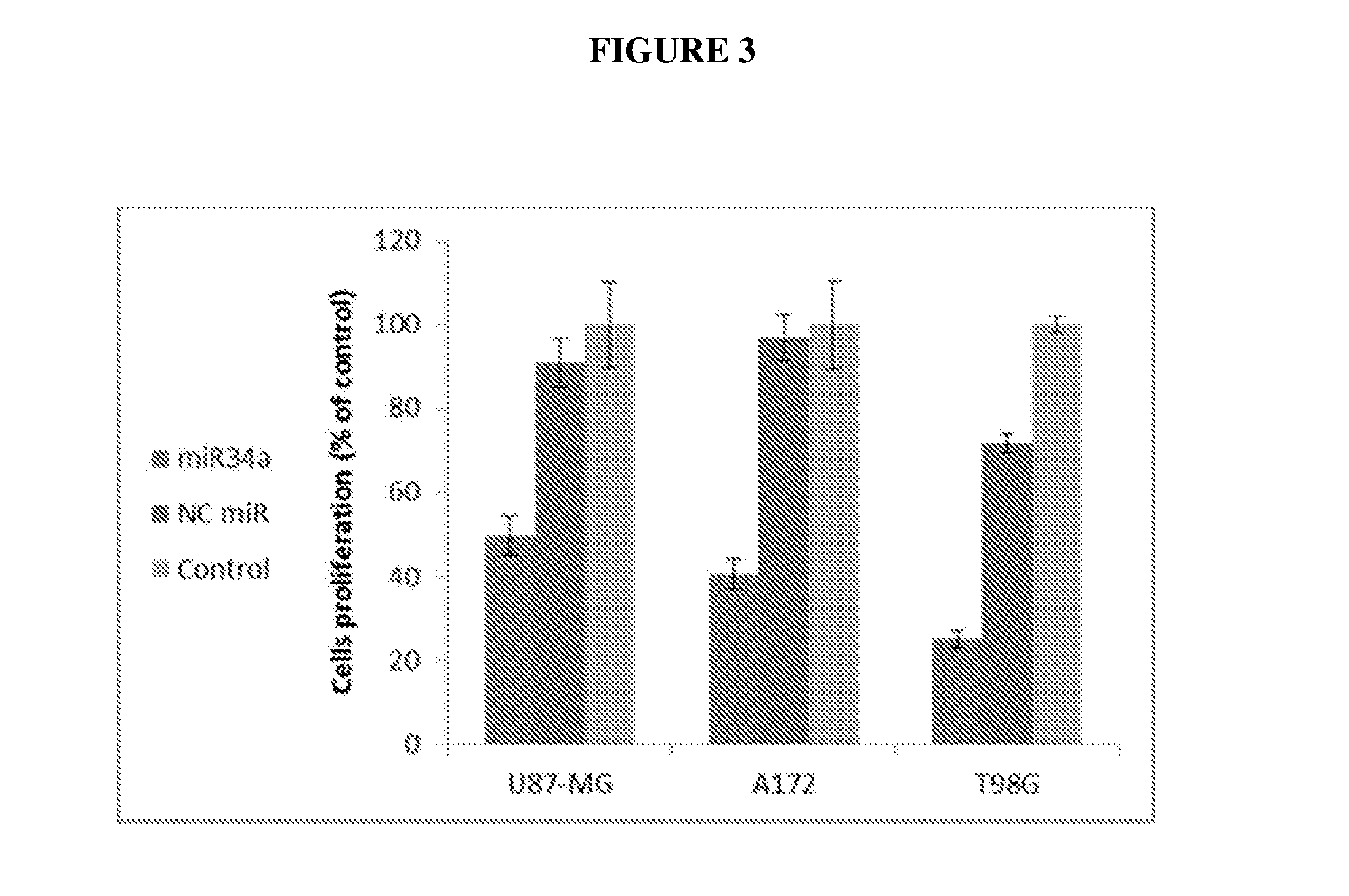Nanocarrier system for micrornas and uses thereof
a micrornas and nephron technology, applied in the field of new drugs, can solve the problem of high recurrence rate of 95% from residual tumor volume, and achieve the effect of improving microrna stability and intracellular trafficking
- Summary
- Abstract
- Description
- Claims
- Application Information
AI Technical Summary
Benefits of technology
Problems solved by technology
Method used
Image
Examples
example 1
PG-NH2-miR Polyplex Formation
[0273]The optimal ratio for the polyplex formation was studied by electrophoretic mobility shift assay (EMSA). 50 pmol of miRNA (miR34a and NC miR) was incubated with PG-NH2 at 1:0.5, 1:1 and 1:2 molar ratios of miRNA to carrier, for 15 min at room temperature (RT). Mobility of free and nanocarrier-complexed miRNA at several N / P ratios was analyzed by agarose gel electrophoresis and is shown in FIG. 2. The best molar ratio was found to be 1:2.
example 2
PG-NH2-miR-34a Polyplex Inhibits Proliferation, Cell Cycle Progression, and Migration of Human Brain Cell Lines
[0274]U-87 MG (malignant glioma cell line), A172 (human gliobastoma cell line) and T88G (human gliobastoma cell line) cells were plated onto a 24-well plate (5×104 cells / well) in DMEM, supplemented with 10% FBS, and incubated for 24 h (37° C.; 5% CO2). The cells were then transfected with PG-NH2-miR34a polyplex (100 nM-miR-equivalent). Cell viability was assessed by Coulter Counter following 7 days. FIG. 3 shows PG-NH2-miR-34a polyplex inhibiting the growth of human glioblastoma cells in vitro. Comparative assays are made by transfecting the cells with miR34a.
example 3
PG-NH2-miR-34a Polyplex Inhibits Migration of Human Brain Cell Lines
[0275]U-87 MG and A172 human glioblastoma cells were transfected with hsa-miR-34a or NC-miR (100 nM-miR-equivalent) complexed with PG-NH2. Three days later, the cell migration assay was performed using modified 8 mm Boyden chambers (two fluid-containing chambers separated by a microporous membrane). Following transfection, cells (2×105 cells / 200 μl) were added to the upper chamber of transwells and allowed to migrate towards the underside of the chamber for 6 hours in the presence of 10% fetal bovine serum (FBS)-containing media in the lower chamber. Untreated human umbilical vein endothelial cells (HUVEC) were seeded in a similar manner, and allowed to migrate towards conditioned media from U-87 MG and A172 cells following transfection. Cells were then fixed with ice-cold methanol and stained (Hema 3 Stain System). The stained migrated cells were imaged using an inverted microscope (Nikon TE2000E) integrated with N...
PUM
| Property | Measurement | Unit |
|---|---|---|
| Fraction | aaaaa | aaaaa |
| Fraction | aaaaa | aaaaa |
| Composition | aaaaa | aaaaa |
Abstract
Description
Claims
Application Information
 Login to View More
Login to View More - R&D
- Intellectual Property
- Life Sciences
- Materials
- Tech Scout
- Unparalleled Data Quality
- Higher Quality Content
- 60% Fewer Hallucinations
Browse by: Latest US Patents, China's latest patents, Technical Efficacy Thesaurus, Application Domain, Technology Topic, Popular Technical Reports.
© 2025 PatSnap. All rights reserved.Legal|Privacy policy|Modern Slavery Act Transparency Statement|Sitemap|About US| Contact US: help@patsnap.com



